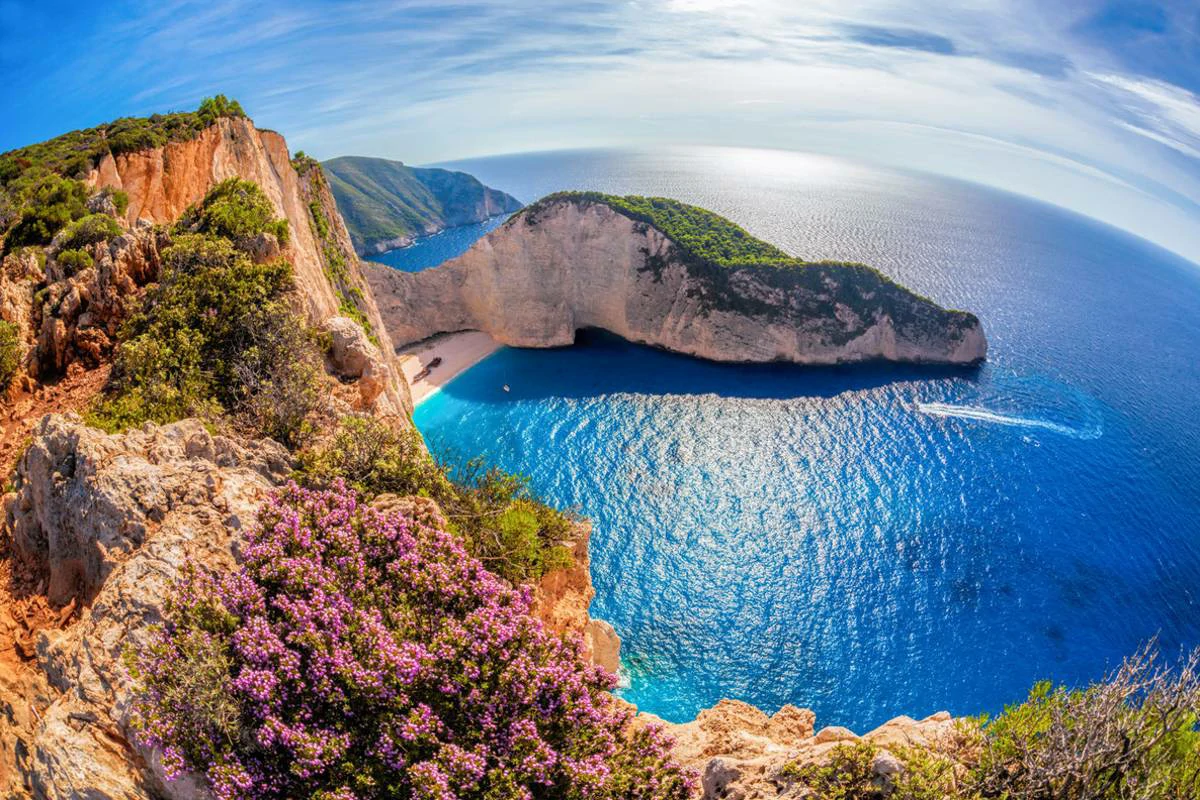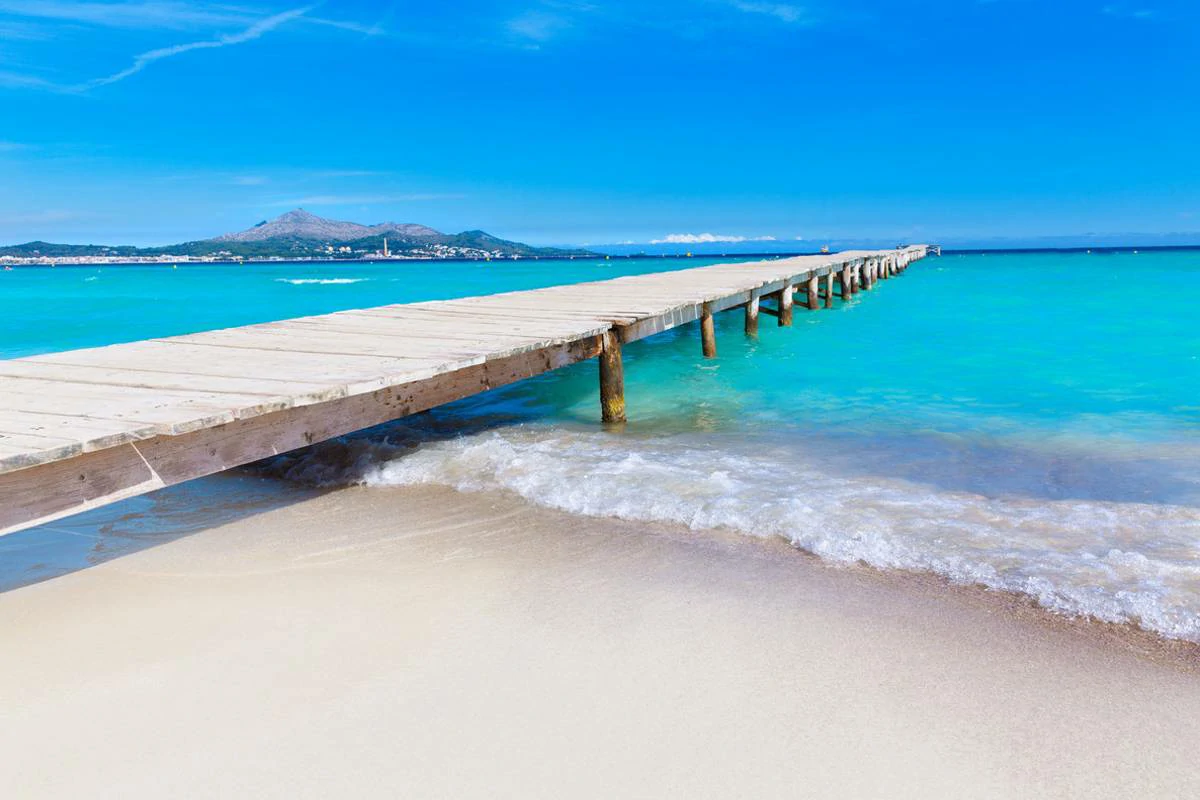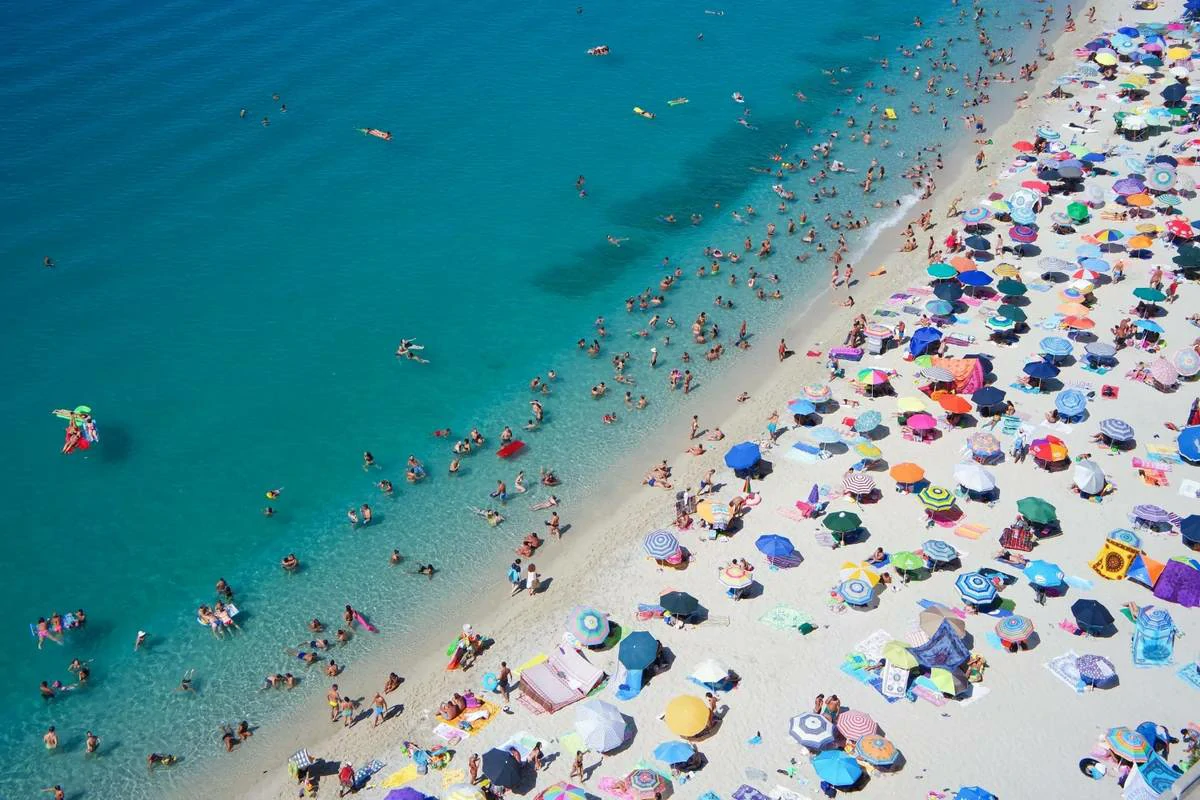Does a beach in Europe have the bluest water in the world? Answer is – Yes! Research indicates that Pasqyra Beach (also called Mirror Beach) in Albania boasts the bluest waters globally. This pristine beach is renowned for its crystal-clear turquoise hues that create a mesmerizing mirror-like reflection of the sky and surrounding landscape.
Summary
- A recent study confirms that a beach located in Europe possesses the world’s bluest water.
- The beach in question is Pasqyra Beach (Mirror Beach) along the coast of Albania.
- The clear waters of Pasqyra Beach achieve a mesmerizing turquoise color that reflects the natural beauty of the area.
- Factors determining the blueness of beach water include depth, water clarity, and the scattering of light.
Does a beach in Europe have the bluest water in the world?

The image of pristine beaches with mesmerizing turquoise water holds an undeniable allure for travelers, promising relaxation and a connection to nature’s beauty.
The intensity of a beach’s blue hue evokes a sense of purity and tranquility, beckoning us to dive into its refreshing depths.
But which beach destinations truly boast the most captivating shades of blue? While tropical paradises often come to mind, recent research has revealed a surprising contender – the European coastline.
The Quest for the World’s Bluest Waters
The quest to identify the beaches with the bluest waters takes a fascinating blend of science and subjective appreciation.
For centuries, poets and artists have sought to capture the ethereal beauty of ocean blues in their works. However, the advent of modern technology has allowed for a more quantifiable approach.
Researchers, such as those at CV Villas, utilize satellite imagery and color analysis tools to pinpoint beaches with water closest to the “ideal” blue.
This involves comparing the RGB color codes of various beaches to the YInMn Blue shade, a vibrant blue pigment discovered serendipitously by scientists at Oregon State University in 2009.
While this provides a fascinating data point, the perception of a beach’s “blueness” still involves elements like water clarity, light conditions, and the surrounding landscape.
Factors Influencing a Beach’s Blue Hue
Several key players interact to produce the stunning shades of blue we admire on coastlines:
Depth and Light: Generally, deeper waters often appear a richer blue. Sunlight penetrates further, and the molecules within seawater scatter the blue wavelengths of light more effectively.
Water Clarity and Sediment: The less sediment, algae, and other matter suspended in the water, the more vividly the blue color shines through. Beaches with clear water free of significant pollutants tend to appear much bluer.
Surrounding Landscape: The presence of lush greenery, contrasting rock formations, and even the color of the sky can influence the perceived blueness of beach waters, adding dimension and brilliance to the scene.
Dr. Sarah Martin Expert Opinion
“The blueness of a beach isn’t just about aesthetics,” explains Dr. Sarah Martin. “It’s an indicator of the overall ecosystem health. Clear, blue waters signal a thriving marine environment with low pollution levels.” Marine Biologist, Dr. Sarah Martin
Science Behind Blue Waters

The dazzling blue hues we associate with pristine beaches aren’t a simple trick of the eye. A complex interplay of physics and biology is at work, transforming sunlight into a breathtaking spectrum that delights the senses. Let’s break down the key factors contributing to ocean color.
Factors Affecting Ocean Color
1. Depth and Light
Sunlight, composed of a spectrum of colors, interacts with seawater in fascinating ways. As the sun’s rays penetrate the water’s surface, different wavelengths of light are absorbed and scattered at varying rates.
Red, orange, and yellow wavelengths (the longer wavelengths) are absorbed rapidly, even at shallow depths.
Blue wavelengths, being shorter, penetrate deeper and are scattered more easily by water molecules.
This scattering creates the perception of blue light when we look out at the ocean, especially in deeper water.
2. Water Clarity and Sediment
The amount of suspended particles in the water drastically influences its color.
Crystal-clear waters, free of significant sediment or debris, allow sunlight to penetrate deeper, intensifying the scattering of the blue wavelengths.
Conversely, areas with high levels of sediment, such as river mouths, often exhibit a murky brown or greenish hue as the suspended particles absorb and scatter a broader range of wavelengths.
3. Algae and Phytoplankton
Microscopic organisms like algae and phytoplankton play a significant role in ocean color.
Blooms containing high concentrations of chlorophyll, a green pigment used for photosynthesis, can change the ocean’s appearance from blue to vibrant green.
These blooms are vital to the marine food chain, but they can also indicate an imbalance in the ecosystem, sometimes caused by excessive nutrient runoff from land.
Dr. William Thompson Expert Opinion
“The intricate relationship between ocean color and marine life cannot be overstated,” explains Dr. William Thompson. “Satellites designed to detect chlorophyll concentrations in seawater give us essential insights into the distribution and health of microscopic organisms that form the base of the ocean food web.” Oceanographer, Dr. William Thompson
Europe’s Contender: Pasqyra Beach, Albania

While many travelers associate vibrant blue waters with tropical destinations, a lesser-known gem on Europe’s coastline is turning heads.
Pasqyra Beach, often referred to as Mirror Beach, is nestled along the Albanian Riviera and boasts captivating turquoise water that rivals any Caribbean paradise.
1. Discovering a Hidden Gem
Location and Features
Pasqyra Beach lies tucked away on the southern coast of Albania, a short distance from the popular resort town of Saranda.
This pristine stretch of coastline is framed by dramatic cliffs and lush greenery, creating a sense of secluded paradise.
The beach itself is composed of smooth pebbles and a gently sloping seabed, offering ideal conditions for swimming and sunbathing.
The “Mirror Beach” Phenomenon
Pasqyra Beach’s nickname, “Mirror Beach,” perfectly captures its most remarkable feature.
The crystal-clear water, combined with the smooth seabed and bright sunlight, creates a breathtaking mirror-like effect.
In calm conditions, the sky and surrounding landscape appear perfectly reflected in the water, blurring the line between sea and horizon.
2. Travel and Accessibility
While its captivating beauty is undeniable, Pasqyra Beach enjoys a more “off-the-beaten-path” status compared to other popular European beach destinations. This brings both advantages and considerations for travelers:
Reaching Pasqyra: The nearest international airport is on the Greek island of Corfu, with ferries connecting to Saranda in Albania. From Saranda, Pasqyra Beach is accessible by car, taxi, or local bus service.
Accommodation: Options currently range from small guesthouses to more basic campsites, appealing to adventurers seeking a true escape. More luxury resort development is planned for the area, which will expand accommodation choices in the future.
Undisturbed Beauty: The relative remoteness of Pasqyra Beach contributes to its unspoiled charm. If pristine nature and fewer crowds are a priority for you, this Albanian gem might be the perfect choice.
Anna Kovacs Expert Opinion
“Pasqyra Beach was a true surprise discovery for me,” reveals Anna Kovacs, who runs a popular European travel blog. “It’s the type of place where you can still have a stretch of the beach to yourself and truly connect with the stunning natural surroundings.” Travel Blogger, Anna Kovacs
Tips for Visiting Pasqyra Beach
Best Time to Visit: Summer months (June-August) offer the warmest water temperatures and sunshine but also experience higher visitor traffic. Consider shoulder seasons (May or September) for a balance of pleasant weather and fewer crowds.
Respect the Environment: Pasqyra Beach’s unspoiled nature is part of its allure. Be mindful of packing out any trash and leaving the area pristine for others to enjoy.
Combine with Other Adventures: The Albanian Riviera boasts numerous other beaches, charming villages, and historic sites like the UNESCO-listed city of Butrint. Consider extending your trip to explore the diverse offerings of this region.
Other Beaches in Europe with Stunning Blue Waters

While Albania’s Pasqyra Beach rightfully claims a top spot for its mesmerizing beauty, the diverse coastlines of Europe hold countless other treasures for those seeking the ultimate blue water escape. Let’s explore a few standouts:
1. Greece’s Blue Water Paradises
The Greek islands, scattered throughout the Aegean and Ionian Seas, are synonymous with idyllic beaches and crystal-clear waters. Here are a few destinations renowned for their captivating shades of blue:
Paralia Mpouka
Nestled on the island of Lefkada in the Ionian Sea, Paralia Mpouka boasts a long stretch of white sand bordering waters of astonishing turquoise intensity.
The dramatic cliffs that frame this beach enhance its picturesque quality, making it a favorite among photographers and beach lovers seeking a visual feast.
Kassiopi, Corfu
With lush green hillsides tumbling down to meet the pristine coastline, Kassiopi, on the northeastern coast of Corfu, provides the perfect blend of natural beauty and authentic Greek charm.
The beaches here are pebbly rather than sandy, but this contributes to the remarkable clarity of the water, revealing dazzling shades of blue and inviting swimmers and snorkelers to explore its depths.
Navagio Beach, Zakynthos
Often called “Shipwreck Beach,” Navagio Beach on the Ionian island of Zakynthos boasts a unique allure.
The rusty shipwreck nestled on its white sand contrasts beautifully with the piercingly blue water.
While accessible primarily by boat, its iconic status draws visitors eager to witness its striking beauty.
2. Turquoise Treasures of the Mediterranean
Stretching across southern Europe, the Mediterranean Sea is home to countless stunning islands and coastal regions prized for their blue water beaches. Here are two highlights:
Sardinia, Italy
The coastline of Sardinia offers a wealth of choices for blue-water enthusiasts.
The beaches of the Costa Smeralda are known for their vibrant hues, while the archipelago of La Maddalena boasts idyllic coves of clear turquoise water nestled amongst granite rock formations.
Blue Lagoon, Malta
Located on the tiny island of Comino, part of the Maltese archipelago, the Blue Lagoon lives up to its name.
Its sheltered waters, enclosed by natural rock formations, achieve an almost luminescent turquoise shade.
While its popularity brings crowds, especially in the peak summer months, its beauty remains undeniable.
Dr. Isabella Rossi Expert Opinion
“The Mediterranean Sea boasts a unique marine ecosystem contributing to the vibrant blue color of its waters in many areas,” explains Dr. Isabella Rossi. “Protecting these coastal environments is vital not only for their beauty but also for the health of the entire marine ecosystem.” Marine Conservationist, Dr. Isabella Rossi
What Does “Bluest Water” Truly Mean?

The pursuit of the bluest beach waters involves a blend of objective scientific analysis and the subjective human experience of color.
While our eyes may be drawn to vibrant turquoise or deep sapphire hues, understanding how the term “bluest” is determined requires a closer look at the science behind it.
1. Explaining the Scientific Analysis Behind the Research
Researchers and travel organizations, like those at CV Villas, utilize several tools and methods to compare and quantify the “blueness” of beaches worldwide:
Satellite Imagery: Satellites capture detailed images of Earth’s surface, including coastal areas. Advanced software can analyze these images to assess water coloration across different geographic regions.
Color Analysis: Researchers break down the color composition of beach water into its RGB (Red, Green, Blue) values. These numerical values provide a way to compare and rank beaches based on the intensity of the blue component of their water.
Depth and Clarity: As discussed earlier, factors like water depth and the presence or absence of sediment significantly influence perceived water color. These elements are typically incorporated into the analysis when identifying beaches with notable blue hues.
2. The Role of the YInMn Blue Color Standard
In 2009, scientists at Oregon State University accidentally discovered a remarkably vibrant blue pigment, which they named YInMn Blue, based on its chemical composition (Yttrium, Indium, Manganese Oxide). This highly stable pigment holds several key advantages:
Ideal Blue Reference: YInMn Blue exhibits a near-perfect pure blue with minimal absorption of red and green wavelengths. This makes it an excellent standard of comparison for determining the “blueness” of other substances or objects, including beach waters.
Quantifiable Comparison: Researchers can compare the RGB values of beach water to the RGB values of YInMn Blue. The closeness of the match provides an objective measure of how “blue” the water appears relative to this ideal blue reference.
Dr. Anya Petrova Expert Opinion
“The science of blue water goes beyond simple beauty”, notes Dr. Anya Petrova. “Analyzing water color can provide clues to water quality, the presence of algae or phytoplankton blooms, and even the effects of climate change on marine environments.” Color Scientist, Dr. Anya Petrova
Conclusion
From the crystal-clear coves of Greek islands to the dramatic coastal landscapes of Albania, Europe’s diverse shorelines offer an unexpected treasure trove of beaches boasting remarkably blue waters.
While scientific analysis gives us tools to compare and categorize these beaches, the allure ultimately lies in the personal experience.
Whether you seek a serene spot to soak up the sun, a vibrant underwater world to explore, or simply the chance to marvel at nature’s breathtaking palette, Europe’s blue water beaches provide the perfect backdrop.
FAQs
Where can I find the bluest water beaches in Europe?
Websites like CV Villas and travel blogs are great resources for up-to-date listings and reviews of Europe’s top beaches with clear turquoise water.
What are the best times of year to visit these beaches?
The summer months (June-August) offer the warmest weather and water temperatures, but also peak crowds. Consider shoulder seasons (May or September) for a balance of pleasant weather and smaller visitor numbers.
Do all blue water beaches have the same characteristics?
Absolutely not! Some beaches boast smooth, white sand, while others feature dramatic pebbles or rock formations. Factors like water depth, surrounding landscape, and proximity to popular resorts will affect the overall experience at each location.
What should I pack for a trip to a blue water beach?
Essentials include your swimsuit, sunscreen, a hat, sunglasses, a beach towel, and plenty of water. For snorkeling or swimming in deeper areas, consider bringing a snorkel mask and fins.
Are there ways to travel sustainably to these beaches?
Here’s how you can minimize your impact:
- Choose locally-owned accommodations and restaurants to support the community.
- Practice “leave no trace” principles, packing out all your trash.
- Opt for reef-safe sunscreen to protect marine life.
- Consider visiting in shoulder seasons to reduce pressure on the environment.







